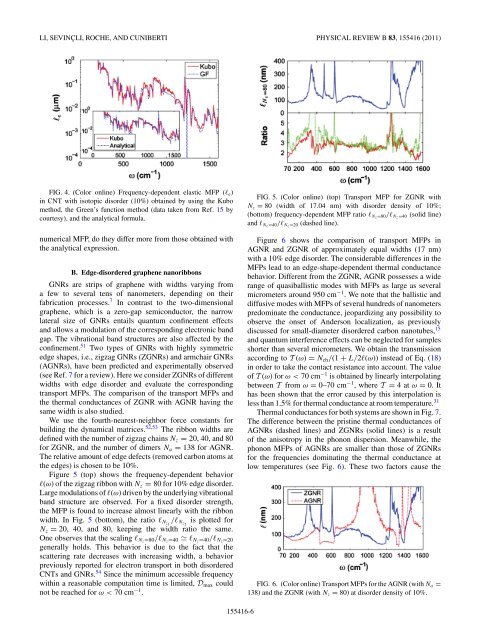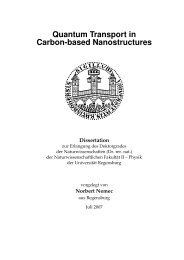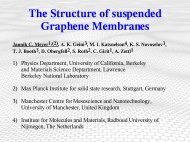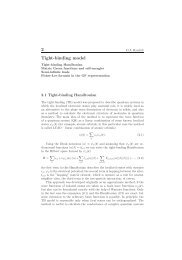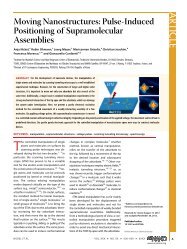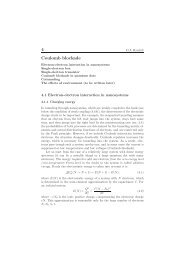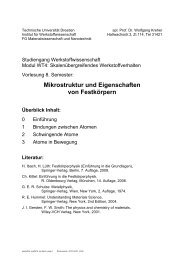Efficient linear scaling method for computing the thermal conductivity ...
Efficient linear scaling method for computing the thermal conductivity ...
Efficient linear scaling method for computing the thermal conductivity ...
Create successful ePaper yourself
Turn your PDF publications into a flip-book with our unique Google optimized e-Paper software.
LI, SEVINÇLI, ROCHE, AND CUNIBERTI PHYSICAL REVIEW B 83, 155416 (2011)<br />
FIG. 4. (Color online) Frequency-dependent elastic MFP (ℓe)<br />
in CNT with isotopic disorder (10%) obtained by using <strong>the</strong> Kubo<br />
<strong>method</strong>, <strong>the</strong> Green’s function <strong>method</strong> (data taken from Ref. 15 by<br />
courtesy), and <strong>the</strong> analytical <strong>for</strong>mula.<br />
numerical MFP, do <strong>the</strong>y differ more from those obtained with<br />
<strong>the</strong> analytical expression.<br />
B. Edge-disordered graphene nanoribbons<br />
GNRs are strips of graphene with widths varying from<br />
a few to several tens of nanometers, depending on <strong>the</strong>ir<br />
fabrication processes. 7 In contrast to <strong>the</strong> two-dimensional<br />
graphene, which is a zero-gap semiconductor, <strong>the</strong> narrow<br />
lateral size of GNRs entails quantum confinement effects<br />
and allows a modulation of <strong>the</strong> corresponding electronic band<br />
gap. The vibrational band structures are also affected by <strong>the</strong><br />
confinement. 51 Two types of GNRs with highly symmetric<br />
edge shapes, i.e., zigzag GNRs (ZGNRs) and armchair GNRs<br />
(AGNRs), have been predicted and experimentally observed<br />
(see Ref. 7 <strong>for</strong> a review). Here we consider ZGNRs of different<br />
widths with edge disorder and evaluate <strong>the</strong> corresponding<br />
transport MFPs. The comparison of <strong>the</strong> transport MFPs and<br />
<strong>the</strong> <strong>the</strong>rmal conductances of ZGNR with AGNR having <strong>the</strong><br />
same width is also studied.<br />
We use <strong>the</strong> fourth-nearest-neighbor <strong>for</strong>ce constants <strong>for</strong><br />
building <strong>the</strong> dynamical matrices. 52,53 The ribbon widths are<br />
defined with <strong>the</strong> number of zigzag chains Nz = 20, 40, and 80<br />
<strong>for</strong> ZGNR, and <strong>the</strong> number of dimers Na = 138 <strong>for</strong> AGNR.<br />
The relative amount of edge defects (removed carbon atoms at<br />
<strong>the</strong> edges) is chosen to be 10%.<br />
Figure 5 (top) shows <strong>the</strong> frequency-dependent behavior<br />
ℓ(ω) of <strong>the</strong> zigzag ribbon with Nz = 80 <strong>for</strong> 10% edge disorder.<br />
Large modulations of ℓ(ω) driven by <strong>the</strong> underlying vibrational<br />
band structure are observed. For a fixed disorder strength,<br />
<strong>the</strong> MFP is found to increase almost <strong>linear</strong>ly with <strong>the</strong> ribbon<br />
width. In Fig. 5 (bottom), <strong>the</strong> ratio ℓNz /ℓNz is plotted <strong>for</strong><br />
1 2<br />
Nz = 20, 40, and 80, keeping <strong>the</strong> width ratio <strong>the</strong> same.<br />
One observes that <strong>the</strong> <strong>scaling</strong> ℓNz=80/ℓNz=40 ℓNz=40/ℓNz=20<br />
generally holds. This behavior is due to <strong>the</strong> fact that <strong>the</strong><br />
scattering rate decreases with increasing width, a behavior<br />
previously reported <strong>for</strong> electron transport in both disordered<br />
CNTs and GNRs. 54 Since <strong>the</strong> minimum accessible frequency<br />
within a reasonable computation time is limited, Dmax could<br />
not be reached <strong>for</strong> ω


